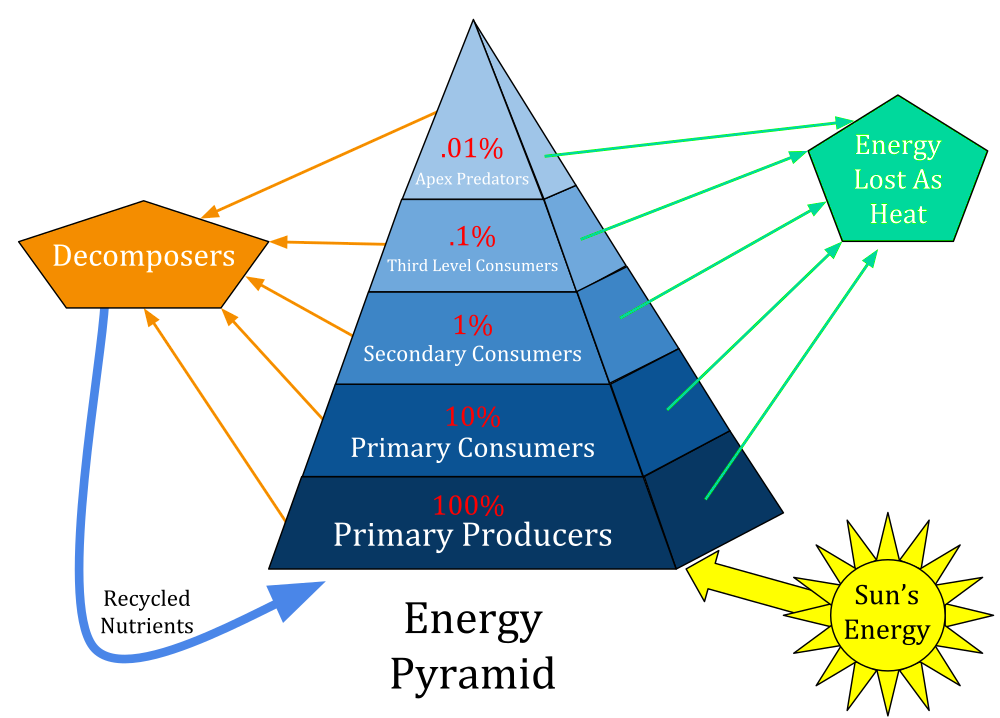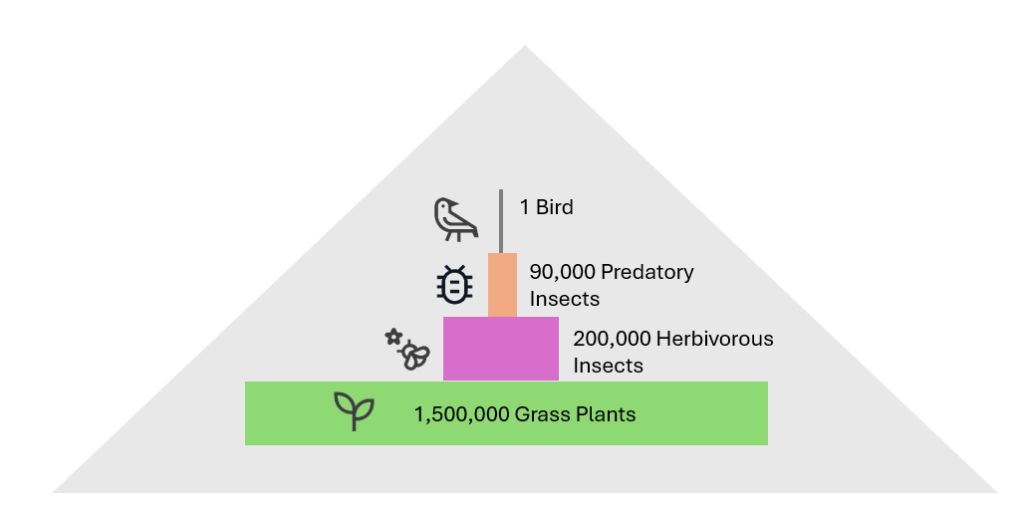10.2 Energy Flow Through Ecosystems
Ecosystem ecology is an extension of organismal, population, and community ecology. The ecosystem comprises all the biotic components (living things) and abiotic components (non-living things) in a particular geographic area. Some of the abiotic components include air, water, soil, and climate. Ecosystem biologists study how nutrients and energy are stored and moved among organisms and the surrounding atmosphere, soil, and water. Ecosystems are powered by two fundamental processes: energy flow and nutrient cycling. These processes are essential for maintaining life and ecosystem stability. Energy flow begins when solar energy is captured by producers through photosynthesis. This energy is then transferred through the ecosystem as organisms consume one another, moving from producers to herbivores, and then to carnivores and decomposers. Unlike nutrients, which are recycled within ecosystems, energy flows in a one-way stream: it enters as sunlight and exits as heat. Nutrient cycling, on the other hand, involves the continuous movement of elements like carbon, nitrogen, and phosphorus between the biotic (living) and abiotic (non-living) components of the ecosystem. Together, these processes link all organisms to each other and to their physical environment, forming the foundation of ecosystem ecology.
Primary Productivity and Energy Budgets
Nearly all life on Earth depends on energy from the sun. In ecosystems, this energy is first captured by producers through the process of photosynthesis. These producers convert sunlight into chemical energy, which becomes the starting point for energy flow through the rest of the ecosystem.
However, only about 1% of the sunlight that reaches Earth’s surface is actually turned into usable energy by producers. This is because most of the sunlight is either reflected, absorbed as heat, or made up of wavelengths that plants can’t use. Producers also use some of the energy they capture to power their own life processes, like growth and repair.
Primary productivity is the amount of energy that producers make available to the rest of the ecosystem. This energy forms the base of the food web and determines how much life an ecosystem can support. Ecosystems like tropical rainforests and wetlands are highly productive, while deserts and the open ocean have much lower productivity per unit area. Despite its low productivity, the open ocean contributes significantly to global primary production because of its vast size.
Understanding primary productivity helps ecologists estimate how much energy is available to support life and how ecosystems respond to changes in the environment.
Energy Transfer and Ecological Pyramids
As energy flows through an ecosystem, it moves from one trophic level to the next – from producers to herbivores, then to carnivores and eventually to decomposers. But this transfer is not very efficient. On average, only about 10% of the energy at one level is passed on to the next. The remaining 90% is lost in various ways – much of it is released as heat during metabolic processes, some is used for movement and other life activities, some is invested in growth, and some is left behind in waste or undigested material.
This pattern of energy loss can be visualized using an ecological pyramid, where each level represents the energy available to organisms at that trophic level. The base of the pyramid is wide, representing the large amount of energy captured by producers. As you move up to herbivores, then to carnivores, the pyramid narrows because less energy is available at each step.

Figure 10.2.1 Image Description
The diagram shows an ecological pyramid of energy flow. At the base are Primary Producers (100%), such as plants, which capture the sun’s energy. Above them are Primary Consumers (10%), like herbivores, followed by Secondary Consumers (1%), and then Third Level Consumers (0.1%). At the very top are Apex Predators (0.01%), representing the smallest amount of available energy. Green arrows point outward to show energy lost as heat at each trophic level. On the left, Decomposers recycle nutrients from all levels back to the ecosystem. A large yellow sun at the bottom right highlights the role of solar energy as the foundation of the system.

Figure 10.2.2 Image Description
The image is a pyramid of numbers showing the population sizes at different trophic levels in an ecosystem. At the base are 1,500,000 grass plants (producers). Above them are 200,000 herbivorous insects that feed on the grass. The next level includes 90,000 predatory insects that consume the herbivores. At the top of the pyramid is 1 bird, representing the highest trophic level. The pyramid illustrates how population numbers decrease as energy flows upward through the food chain.
Knowledge Check
Text Description
- soil
- moved
- air
- atmosphere
- Ecosystem
- water
- nutrients
- abiotic
- stored
- biotic
- energy
- organismal, population, and community
- Wind energy
- Tidal movement
- Geothermal heat
- Solar energy
- About 10%
- About 25%
- About 1%
- About 50%
- It is recycled back to producers
- It increases at each level
- It is stored in predators for long-term use
- It is lost as heat, movement, or waste
- Tropical rainforest
- Desert
- Wetland
- Open ocean
- Herbivores cannot digest producers efficiently
- Too many predators compete for limited prey
- Ecosystems run out of physical space
- Energy is lost at each level, limiting how many levels can be supported
Correct Answers:
- Ecosystem ecology is an extension of organismal, population, and community ecology. The ecosystem comprises all the biotic components (living things) and abiotic components (non-living things) in a particular geographic area. Some of the abiotic components include air, water, soil, and climate. Ecosystem biologists study how nutrients and energy are stored and moved among organisms and the surrounding atmosphere, soil, and water.
- d. Solar energy
- c. About 1%
- d. It is lost as heat, movement, or waste
- d. Open ocean.
OpenAI. (2025). ChatGPT. [Large language model]. https://chat.openai.com/chat
Prompt: Create 5 multiple-choice questions using the following content
“18.1 Importance of Biodiversity” from Biology and the Citizen by Colleen Jones is licensed under a Creative Commons Attribution 4.0 International License, except where otherwise noted.
“46.2: Energy Flow through Ecosystems” from Unit VIII: Ecology by LibreTexts is licensed under a Creative Commons Attribution 4.0 International License, except where otherwise noted.

